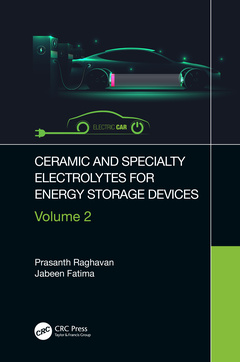Description
Ceramic and Specialty Electrolytes for Energy Storage Devices
Coordinators: Raghavan Prasanth, Fatima Jabeen
Language: English
Subjects for Ceramic and Specialty Electrolytes for Energy Storage...:
Keywords
Ionic Conductivity; Direct Methanol Fuel Cells; batteries; Energy Storage Devices; lithium-ion batteries; EVs; supercapacitors; Energy Density; electrochemical energy storage; Solid State Electrolyte; ceramic materials; Lithium Ion Batteries; solid electrolytes; Polymer Electrolytes; quasi-solid electrolytes; Electrochemical Performance; Ceramic solid electrolytes; Solid Polymer Electrolyte; High Ionic Conductivity; Temperature Dependent Ionic Conductivity; Ion transportation mechanism; Polymer Blend Electrolyte; Sodium-ion batteries; Lithium Ion Conductors; QSSEs; Methanol Crossover; Lithium Salts; Li Ion Conductors; Inorganic Solid Electrolytes; mS Cm; Fuel Cells; PEMFC; LFP; PVP; Ethylene Alt Maleic Anhydride
· 15.6x23.4 cm · Hardback
Description
/li>Contents
/li>Biography
/li>
Ceramic and Specialty Electrolytes for Energy Storage Devices, Volume II, investigates recent progress and challenges in a wide range of ceramic solid and quasi-solid electrolytes and specialty electrolytes for energy storage devices. The influence of these electrolyte properties on the performance of different energy storage devices is discussed in detail.
Features:
? Offers a detailed outlook on the performance requirements and ion transportation mechanism in solid polymer electrolytes
? Covers solid-state electrolytes based on oxides (perovskite, anti-perovskite) and sulfide-type ion conductor electrolytes for lithium-ion batteries followed by solid-state electrolytes based on NASICON and garnet-type ionic conductors
? Discusses electrolytes employed for high-temperature lithium-ion batteries, low-temperature lithium-ion batteries, and magnesium-ion batteries
? Describes sodium-ion batteries, transparent electrolytes for energy storage devices, non-platinum-based cathode electrocatalyst for direct methanol fuel cells, non-platinum-based anode electrocatalyst for direct methanol fuel cells, and ionic liquid-based electrolytes for supercapacitor applications
? Suitable for readers with experience in batteries as well as newcomers to the field
This book will be invaluable to researchers and engineers working on the development of next-generation energy storage devices, including materials and chemical engineers, as well as those involved in related disciplines.
Dr. Prasanth Raghavan, Professor, at Department of Polymer Science and Rubber Technology, Cochin University of Science and Technology (CUSAT), and Visiting Professor at Department of Materials Engineering and Convergence Technology, Gyeongsang National University, Republic of Korea. He received his PhD in Engineering under the guidance of Prof. Jou-Hyeon Ahn, from Department of Chemical and Biological Engineering, Geyongsang National University, Republic of Korea, in 2009, under prestigious Brain Korea (BK21) Fellowship. He completed his B.Tech and M.Tech from CUSAT, India. After a couple of years of attachment stint as Project Scientist at Indian Institute of Technology (IIT-D), New Delhi, he moved to abroad for his PhD studies in 2007. His PhD research was focused on fabrication and investigation of nanoscale fibrous electrolytes for high performance energy storage devices. He completed his Engineering doctoral degree in less than three years and still it’s an unbroken record in Republic of Korea. After the PhD, Dr. Prasanth joined as Research Scientist at Nanyang Technological University (NTU), Singapore in collaboration with Energy Research Institute at NTU (ERI@N) and TUM CREATE, a joint electromobility research centre between Germany's Technische Universität München (TUM) and NTU, where he was working with Prof. Rachid Yazami, the one who has successfully introduced graphitic carbon as anode for commercial lithium ion batteries, and received Draper Prize along with the Nobel Laurates Prof. J. B. Goodenough and Prof. Akira Yoshino. After four years in Singapore, Dr. Prasanth moved to Rice University, USA as Research Scientist where he was working with Prof. Pulickal M Ajayan, the co-inventor of Carbon Nanotubes, and lucky to work with 2019 Chemistry Nobel laurate Prof. J. B. Goodenough. Dr. Prasanth was selected for Brain Korea Fellowship (2007), SAGE Research Foundation Fellowship, Brazil (2009), Estonian Science Foundation Fellowship, European Science Fou




